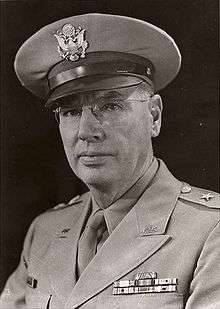George F. Moore (general)
George Fleming Moore (July 31, 1887 – December 2, 1949) was a highly decorated officer of the United States Army with the rank of major general. General Moore commanded the Harbor Defenses of Manila and Subic Bays and the Philippine Coast Artillery during the Battle of Bataan.[1]
George Fleming Moore | |
|---|---|
 Major General George Fleming Moore | |
| Born | July 31, 1887 Austin, Texas |
| Died | December 2, 1949 (aged 62) Hillsborough, California |
| Buried | |
| Allegiance | |
| Service/ | |
| Years of service | 1909–1949 |
| Rank | |
| Commands held | Harbor Defenses of Manila and Subic Bays |
| Battles/wars | World War I World War II |
| Awards | Distinguished Service Cross Distinguished Service Medal (2) |
Early life and education
George Fleming Moore was born on July 31, 1887 in Austin, Texas as the son of John Marks Moore, Jr. and Mary Estelle Grace Moore. He graduated from A&M College of Texas in 1908 and received a commission in 1909 into the Coast Artillery Corps.
Texas A&M
A major and lieutenant colonel during World War I, he returned to Texas A&M as Commandant of Cadets from 1937–1940, where he was promoted to colonel.[2][3]
World War II
In World War II, then Brigadier General Moore fought in the Bataan Campaign, later becoming the commander of the Harbor Defenses of Manila and Subic Bays in the Philippines, both during the 1941–42 Japanese invasion.[4] He was given command of the Philippine Coast Artillery with roughly 5,000 men and four forts to defend Corregidor.[5] On May 6, 1942, General Jonathan Wainwright surrendered the Corregidor garrison at about 1:30 p.m., leading himself and General Moore to be captured by the Japanese, and held as a POW, later liberated in August 1945. General Moore was awarded the Distinguished Service Cross and Distinguished Service Medal while in captivity.[6]
Family
He was married to Lucile (Lucille) Griffith (March 10, 1892 – April 5, 1972), daughter of John Williams Griffith and Mary Elizabeth (Fox) of Port Townsend, WA. They had one daughter, Anne (later Mrs. Burton R. Browne).
Death
Moore never recovered his health from captivity; he shot himself on December 2, 1949, shortly after retirement, in Hillsborough, CA. The Moores are buried at Golden Gate National Cemetery, San Bruno, California.
Awards and honors
Moore received some of the Army´s highest decorations including the Distinguished Service Cross and the Distinguished Service Medal with Oak Leaf Cluster.[7]
Moore Hall, a residence hall at Texas A&M University, is named in his honor.
Ribbon bar
| 1st Row | Distinguished Service Cross | |||||||||||
|---|---|---|---|---|---|---|---|---|---|---|---|---|
| 2nd Row | Army Distinguished Service Medal w/ Oak Leaf Cluster | World War I Victory Medal | American Defense Service Medal with Foreign Service Clasp | |||||||||
| 3rd Row | Asiatic-Pacific Campaign Medal w/ two Service Stars | World War II Victory Medal | Philippine Defense Medal w/ Bronze star | |||||||||
See also
| Wikimedia Commons has media related to George Fleming Moore. |
References
- http://www.generals.dk/general/Moore/George_Fleming/USA.html
- "Muster Archived September 27, 2007, at the Wayback Machine
- "Residence Hall Living – Moore Hall Archived September 1, 2006, at the Wayback Machine
- John A. Adams (April 15, 2016). The Fightin' Texas Aggie Defenders of Bataan and Corregidor. Texas A&M University Press. pp. 248–. ISBN 978-1-62349-423-0.
- Dominic J. Caraccilo (June 29, 2005). Surviving Bataan and Beyond: Colonel Irvin Alexander's Odyssey as a Japanese Prisoner of War. Stackpole Books. pp. 311–. ISBN 978-0-8117-4155-2.
- "Major General George F. Moore Archived June 9, 2007, at the Wayback Machine
- "Valor awards for George F. Moore". valor.militarytimes.com.